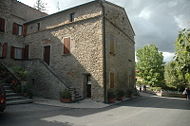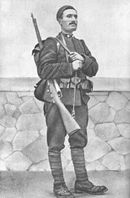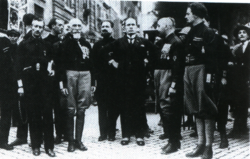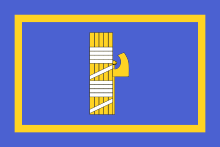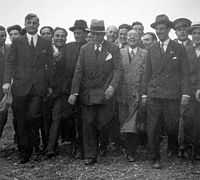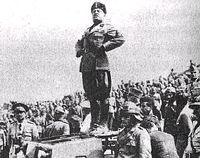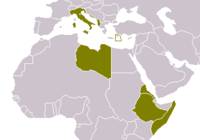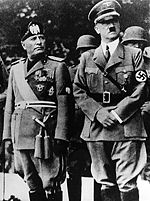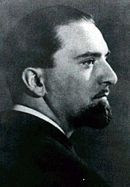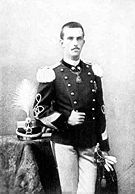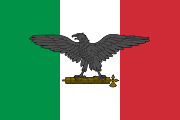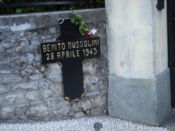Benito Mussolini
2008/9 Schools Wikipedia Selection. Related subjects: Political People; World War II
|
Benito Mussolini
|
|
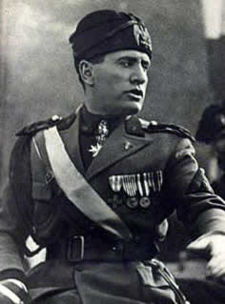 |
|
|
40th
Prime Minister of Italy |
|
|---|---|
| In office October 31, 1922 – July 25, 1943 |
|
| Monarch | Victor Emmanuel III |
| Preceded by | Luigi Facta |
| Succeeded by | Pietro Badoglio (Provisional Military Government) |
|
Duce of the Italian Social Republic
|
|
| In office September 23, 1943 – April 26, 1945 |
|
|
|
|
| Born | July 29, 1883 Predappio, Italy |
| Died | April 28, 1945 (aged 61) Giulino di Mezzegra, Italy |
| Nationality | Italian |
| Political party | Republican Fascist Party (1943-1945) National Fascist Party (1921-1943) Italian Socialist Party (1901-1914) |
| Spouse | Rachele Mussolini |
| Profession | Politician, Journalist |
| Religion | Converted to Roman Catholicism in 1927, irreligious in earlier life. |
Benito Amilcare Andrea Mussolini ( July 29, 1883 – April 28, 1945) was an Italian politician who led the National Fascist Party and is credited with being one of the key figures in the creation of Fascism. He became the Prime Minister of Italy in 1922 and began using the title Il Duce by 1925. Mussolini continued on in this role until he was replaced in 1943; for a short period after this until his death Mussolini was the leader of the Italian Social Republic.
Mussolini was among the founders of Italian fascism, which included elements of nationalism, corporativism, national syndicalism, expansionism, social progress and anti-communism in combination with censorship of subversives and state propaganda. In the years following his creation of the fascist ideology, Mussolini influenced, or achieved admiration from, a wide variety of political figures.
Among the domestic achievements of Mussolini from the years 1924–1939 were: his public works programmes such as the taming of the Pontine Marshes, the improvement of job opportunities, and public transport. Mussolini also solved the Roman Question by concluding the Lateran Treaty between the Kingdom of Italy and the Holy See. He is also credited with securing economic success in Italy's colonies and commercial dependencies.
Although he initially favoured siding with France against Germany in the early 1930s, Mussolini became one of the main figures of the Axis powers and, on 10 June 1940, Mussolini led Italy into World War II on the side of Axis. Three years later, Mussolini was deposed at the Grand Council of Fascism, prompted by the Allied invasion. Soon after his incarceration began, Mussolini was rescued from prison in the daring Gran Sasso raid by German special forces.
Following his rescue, Mussolini headed the Italian Social Republic in parts of Italy that were not occupied by Allied forces. In late April, 1945, with total defeat looming, Mussolini attempted to escape to Switzerland, only to be captured and summarily executed near Lake Como by Communist Italian partisans. His body was taken to Milan where it was hung upside down at a petrol station for public viewing and to provide confirmation of his demise.
Early life
Mussolini was born in Dovia di Predappio, a humble rural town in the province of Forlì in Emilia-Romagna. Mussolini was born into a working class background; his father Alessandro Mussolini was a blacksmith and a socialist activist, while his mother Rosa Mussolini (née Maltoni) was a school teacher; unlike her husband, she was a devout Catholic. Owing to his father's political leanings Mussolini was named Benito after Mexican reformist President Benito Juárez; while his middle names Andrea and Amilcare were from Italian socialists Andrea Costa and Amilcare Cipriani. Benito was the eldest of his parent's three children. His siblings Arnaldo and Edvige followed.
As a young boy, Mussolini would spend time helping his father in his blacksmithing. It was likely here that he was exposed to his father's significant political beliefs. Alessandro was a socialist and a republican, but also held some nationalistic views, especially in regards to some of the Italians who were living under the rule of the Austro-Hungarian Empire., which were not consistent with the internationalist socialism of the time. The conflict between his parents about religion meant that, unlike most Italians, Mussolini was not baptised at birth and would not be until much later in life. However, as a compromise with his mother, Mussolini was sent to a boarding school run by monks. Mussolini was rebellious and was expelled after a series of behaviour related incidents, including throwing stones at the congregation after Mass, stabbing a fellow student in the hand and throwing an inkpot at a teacher. After joining a new school, Mussolini achieved good grades, and qualified as an elementary schoolmaster in 1901.
Political journalist and soldier
In 1902, Mussolini emigrated to Switzerland to find work and to expand his political horizons. During a period when he was unable to find a permanent job there, he was arrested for vagrancy and jailed for one night. Later, after becoming involved in the socialist movement, he was deported to Italy and volunteered for military service. Mussolini found a job in February 1908 in the city of Trento, which was ethnically Italian but then under the control of Austria-Hungary. He did office work for the local socialist party and edited its newspaper L'Avvenire del Lavoratore ("The Future of the Worker"). It did not take him long to make contact with irredentist politician and journalist Cesare Battisti, and to agree to write for and edit his newspaper Il Popolo ("The People") in addition to the work he did for the party.
In 1915, he had a son with Ida Dalser, a woman born in Sopramonte, a village near Trento. By the time Mussolini's novel was printed in Il Popolo, Mussolini was already back in Italy. His growing defiance of Royal authority and anti-clericalism got him in trouble with the authorities until he was finally deported at the end of September. He was prompted to return to Italy once again when his mother became ill. He became a journalist for the socialist newspaper, Avanti! (Forward!). After initially writing on numerous occasions against the war in the socialist paper Avanti, Mussolini relented and he and his class were called up in August of 1915 for active duty.
Although his military record was unremarkable, it was without blemish and it has been suggested that he may have been prevented from moving further along in the ranks due to his ongoing political agitation in various periodicals. Mussolini's military experience is told in his work Diario Di Guerra. Overall he totalled about 9 months of active, front-line trench warfare. During this time he contracted paratyphoid fever. His military exploits ended in 1917 when he was wounded accidentally by the explosion of a mortar bomb in his trench. He was left with at least 40 shards of metal in his body He was discharged from the hospital in August 1917 and resumed his editor-in-chief position at his new paper, Il Popolo d'Italia.
Creation of Fascism
By the time Mussolini returned from Allied service in the First World War, he had decided that socialism as a doctrine had largely been a failure, although he still called his paper socialist. In early 1918, Mussolini called for the emergence of a man "ruthless and energetic enough to make a clean sweep" to revive the Italian nation. Much later in life Mussolini said he felt by 1919 "Socialism as a doctrine was already dead; it continued to exist only as a grudge". On March 23, 1919, Mussolini reformed the Milan fascio as the Fasci Italiani di Combattimento (Italian Combat Squad), consisting of 200 members.
An important factor in fascism gaining support in its earliest stages was the fact that it opposed discrimination based on social class and was strongly opposed to all forms of class war. Fascism instead supported nationalist sentiments such as a strong unity, regardless of class, in the hopes of raising Italy up to the levels of its great Roman past. This side of fascism endeared itself to the aristocracy and the bourgeois, as it promised to protect their existence; after the Russian Revolution, they had greatly feared the prospect of a bloody class war coming to Italy by the hand of the communists and the socialists. Mussolini did not ignore the plight of the working class, however, and he gained their support with stances such as those in The Manifesto of the Fascist Struggle, published in June 1919. In the manifesto he demanded, amongst other things, creation of a minimum wage, showing the same confidence in labor unions (which prove to be technically and morally worthy) as was given to industry executives or public servants, voting rights for women, and the systemisation of public transport such as railways.
Mussolini and the fascists managed to be simultaneously revolutionary and traditionalist; because this was vastly different to anything else in the political climate of the time, it is sometimes described as "The Third Way". The Fascisti, led by one of Mussolini's close confidants, Dino Grandi, formed armed squads of war veterans called Blackshirts (or squadristi) with the goal of restoring order to the streets of Italy with a strong hand. The blackshirts clashed with communists, socialists and anarchists at parades and demonstrations; all of these factions were also involved in clashes against each other. The government rarely interfered with the blackshirts' actions, due in part to a looming threat and widespread fear of a communist revolution. The Fascisti grew so rapidly that within two years, it transformed itself into the National Fascist Party at a congress in Rome. Also in 1921, Mussolini was elected to the Chamber of Deputies for the first time.
March on Rome and early years in power
The March on Rome was a coup d'état by which Mussolini's National Fascist Party came to power in Italy and ousted Prime Minister Luigi Facta. The "march" took place in 1922 between October 27 and October 29. On October 28, King Victor Emmanuel III refused his support to Facta and handed over power to Mussolini. Mussolini was supported by the military, the business class, and the liberal right-wing.
As Prime Minister, the first years of Mussolini's rule were characterized by a right-wing coalition government composed of Fascists, nationalists, liberals and even two Catholic ministers from the Popular Party. The Fascists made up a small minority in his original governments. Mussolini's domestic goal, however, was the eventual establishment of a totalitarian state with himself as supreme leader ( Il Duce) a message that was articulated by the Fascist newspaper Il Popolo, which was now edited by Mussolini's brother, Arnaldo. To that end, Mussolini obtained dictatorial powers for one year. He favored the complete restoration of state authority, with the integration of the Fasci di Combattimento into the armed forces (the foundation in January 1923 of the Milizia Volontaria per la Sicurezza Nazionale) and the progressive identification of the party with the state. In political and social economy, he passed legislation that favored the wealthy industrial and agrarian classes (privatisations, liberalisations of rent laws and dismantlement of the unions).
In 1923, Mussolini sent Italian forces to invade Corfu during the " Corfu Incident." In the end, the League of Nations proved powerless and Greece was forced to comply with Italian demands.
Acerbo Law
In June 1923, the government passed the Acerbo Law, which transformed Italy into a single national constituency. It also granted a two-thirds majority of the seats in Parliament to the party or group of parties which had obtained at least 25 percent of the votes. This law was punctually applied in the elections of April 6, 1924. The "national alliance", consisting of Fascists, most of the old Liberals and others, won 64 percent of the vote largely by means of violence and voter intimidation. These tactics were especially prevalent in the south.
Squadristi violence
The assassination of the socialist deputy Giacomo Matteotti, who had requested the annulment of the elections because of the irregularities committed, provoked a momentary crisis of the Mussolini government. The murderer, a squadrista named Amerigo Dumini, reported to Mussolini soon after the murder. Mussolini ordered a cover-up, but witnesses saw the car used to transport Matteotti's body parked outside Matteotti's residence, which linked Dumini to the murder. The Matteotti crisis provoked cries for justice against the murder of an outspoken critic of Fascist violence. The government was shocked into paralysis for a few days, and Mussolini later confessed that a few resolute men could have alerted public opinion and started a coup that would have swept fascism away. Dumini was imprisoned for two years. On release he told others that Mussolini was responsible, for which he served further prison time. For the next 15 years, Dumini received an income from Mussolini, the Fascist Party, and other sources. This may have been hush money, for he left a dossier full of incriminating evidence to a Texas lawyer in case of his own death.
The opposition parties responded weakly or were generally unresponsive. Many of the socialists, liberals and moderates boycotted Parliament in the Aventine Secession, hoping to force Victor Emmanuel to dismiss Mussolini. Despite the leadership of communists such as Antonio Gramsci, socialists such as Pietro Nenni and liberals such as Piero Gobetti and Giovanni Amendola, a mass antifascist movement never caught fire. The king, fearful of violence from the Fascist squadristi, kept Mussolini in office. Because of the boycott of Parliament, Mussolini could pass any legislation unopposed. The political violence of the squadristi had worked, for there was no popular demonstration against the murder of Matteotti.
Within his own party, Mussolini faced doubts and dissension during these critical weeks. The militant members of the party were angry that only a few dozen had been killed and a bloodbath ensued, causing thousands of casualties.
On December 31, 1924, 31 MVSN consuls met with Mussolini and gave him an ultimatum--crush the opposition or they would do so without him. Fearing a revolt by his own militants, Mussolini decided to drop all trappings of democracy. On January 3, 1925, Mussolini made a truculent speech before the Chamber in which he took responsibility for squadristi violence (though he did not mention the assassination of Matteotti). He also promised a crackdown on dissenters. Before his speech, MVSN detachments beat up the opposition and prevented opposition newspapers from publishing. Mussolini correctly predicted that as soon as public opinion saw him firmly in control the "fence-sitters", the silent majority and the "place-hunters" would all place themselves behind him. This is considered the onset of Mussolini's dictatorship. From late 1925 until the mid-1930s, fascism experienced little and isolated opposition, although that which it did was memorable.
While failing to outline a coherent program, Fascism evolved into a new political and economic system that combined totalitarianism, nationalism, anti-communism, anti-capitalism and anti-liberalism into a state designed to bind all classes together under a corporatist system (the "Third Way"). This was a new system in which the state seized control of the organisation of vital industries. Under the banners of nationalism and state power, Fascism seemed to synthesise the glorious Roman past with a futuristic utopia.
Building a dictatorship
Assassination attempts
Mussolini's influence in propaganda was such that he had surprisingly little opposition to suppress. Nonetheless, he was "slightly wounded in the nose" when he was shot on April 7, 1926 by Violet Gibson, an Irish woman and sister of Baron Ashbourne. In January 1927, 15-year-ld Anteo Zamboni attempted to shoot Mussolini in Bologna. Zamboni was lynched on the spot. Mussolini also survived a failed assassination attempt in Rome by anarchist Gino Lucetti, and a planned attempt by American anarchist Michael Schirru, which ended with Schirru's capture and execution. Members of TIGR, a Slovene anti-fascist group, plotted to kill Mussolini in Kobarid in 1938, but their attempt was unsuccessful.
Police state
At various times after 1922, Mussolini personally took over the ministries of the interior, foreign affairs, colonies, corporations, defense, and public works. Sometimes he held as many as seven departments simultaneously, as well as the premiership. He was also head of the all-powerful Fascist Party and the armed local fascist militia, the MVSN or "Blackshirts," who terrorised incipient resistances in the cities and provinces. He would later form the OVRA, an institutionalised secret police that carried official state support. In this way he succeeded in keeping power in his own hands and preventing the emergence of any rival.
Over the next two years, Mussolini progressively dismantled virtually all constitutional and conventional restraints on his power, thereby building a police state. A law passed on Christmas Eve 1925 changed Mussolini's formal title from "president of the Council of Ministers" to "head of the government." He was no longer responsible to Parliament and could only be removed by the king. While the Italian constitution stated that ministers were only responsible to the sovereign, in practice it had become all but impossible to govern against the express will of Parliament. The Christmas Eve law ended this practice, and also made Mussolini the only person competent to determine the body's agenda. Local autonomy was abolished, and podestas appointed by the Italian Senate replaced elected mayors and councils.
All other parties were outlawed in 1928, though in practice Italy had been a one-party state since Mussolini's 1925 speech. In the same year, an electoral law abolished parliamentary elections. Instead, the Grand Council of Fascism selected a single list of candidates to be approved by plebiscite. The Grand Council had been created five years earlier as a party body but was "constitutionalised" and became the highest constitutional authority in the state. The Grand Council also had the power to recommend Mussolini's removal from office, and was thus theoretically the only check on his power. However, only Mussolini could summon the Grand Council and determine its agenda.
Economic policy
Mussolini launched several public construction programs and government initiatives throughout Italy to combat economic setbacks or unemployment levels. His earliest, and one of the best known, was Italy's equivalent of the Green Revolution, known as the "Battle for Grain", in which 5,000 new farms were established and five new agricultural towns on land reclaimed by draining the Pontine Marshes. This plan diverted valuable resources to grain production, away from other less economically viable crops. The huge tariffs associated with the project promoted widespread inefficiencies, and the government subsidies given to farmers pushed the country further into debt. Mussolini also initiated the "Battle for Land", a policy based on land reclamation outlined in 1928. The initiative had a mixed success; while projects such as the draining of the Pontine Marsh in 1935 for agriculture were good for propaganda purposes, provided work for the unemployed and allowed for great land owners to control subsidies, other areas in the Battle for Land were not very successful. This program was inconsistent with the Battle for Grain (small plots of land were inappropriately allocated for large-scale wheat production), and the Pontine Marsh was lost during World War II. Fewer than 10,000 peasants resettled on the redistributed land, and peasant poverty remained high. The Battle for Land initiative was abandoned in 1940.
He also combated an economic recession by introducing the "Gold for the Fatherland" initiative, by encouraging the public to voluntarily donate gold jewellery such as necklaces and wedding rings to government officials in exchange for steel wristbands bearing the words "Gold for the Fatherland". Even Rachele Mussolini donated her own wedding ring. The collected gold was then melted down and turned into gold bars, which were then distributed to the national banks.
Mussolini pushed for government control of business: by 1935, Mussolini claimed that three quarters of Italian businesses were under state control. That same year, he issued several edicts to further control the economy, including forcing all banks, businesses, and private citizens to give up all their foreign-issued stocks and bonds to the Bank of Italy. In 1938, he also instituted wage and price controls. He also attempted to turn Italy into a self-sufficient autarky, instituting high barriers on trade with most countries except Germany.
Government by propaganda
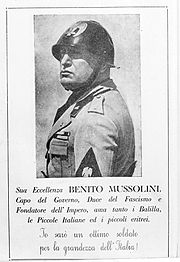
As dictator of Italy, Mussolini's foremost priority was the subjugation of the minds of the Italian people and the use of propaganda to do so; whether at home or abroad, and here his training as a journalist was invaluable. Press, radio, education, films—all were carefully supervised to create the illusion that fascism was the doctrine of the twentieth century, replacing liberalism and democracy.
The principles of this doctrine were laid down in the article on fascism, written by Giovanni Gentile and signed by Mussolini that appeared in 1932 in the Enciclopedia Italiana. In 1929, a concordat with the Vatican was signed, the Lateran treaties, by which the Italian state was at last recognised by the Roman Catholic Church, and the independence of Vatican City was recognised by the Italian state. In 1927, Mussolini was baptised by a Roman Catholic priest in order to take away certain Catholic opposition, who were still very critical of a regime which had taken away papal property and virtually blackmailed the Vatican. However, Mussolini was never known to be a practicing Catholic, and was privately very hostile to the church. Since 1927, and more even after 1929, Mussolini, with his anti-Communist doctrines, convinced many Catholics to actively support him. In the encyclical Non abbiamo bisogno, Pope Pius XI attacked the Fascist regime for its policy against the Catholic Action and certain tendencies to overrule Catholic education morals.
The law codes of the parliamentary system were rewritten under Mussolini. All teachers in schools and universities had to swear an oath to defend the fascist regime. Newspaper editors were all personally chosen by Mussolini and no one who did not possess a certificate of approval from the fascist party could practice journalism. These certificates were issued in secret; Mussolini thus skillfully created the illusion of a "free press". The trade unions were also deprived of any independence and were integrated into what was called the "corporative" system. The aim (never completely achieved), inspired by medieval guilds, was to place all Italians in various professional organizations or "corporations", all of which were under clandestine governmental control.
Large sums of money were spent on highly visible public works, and on international prestige projects such as the SS Rex Blue Riband ocean liner and aeronautical achievements such as the world's fastest seaplane the Macchi M.C.72 and the transatlantic flying boat cruise of Italo Balbo, who was greeted with much fanfare in the United States when he landed in Chicago.
Foreign policy
In foreign policy, Mussolini soon shifted from the pacifist anti- imperialism of his lead-up to power to an extreme form of aggressive nationalism. He dreamt of making Italy a nation that was "great, respected and feared" throughout Europe, and indeed the world. An early example was his bombardment of Corfu in 1923. Soon after he succeeded in setting up a puppet regime in Albania and in ruthlessly consolidating Italian power in Libya, which had been loosely a colony since 1912. It was his dream to make the Mediterranean mare nostrum ("our sea" in Latin), and he established a large naval base on the Greek island of Leros to enforce a strategic hold on the eastern Mediterranean. However, his first 'baby steps' into foreign policy seemed to portray him as a 'statesman', for he participated in the Locarno Treaties of 1925 and the attempted Four Power Pact of 1933 was Mussolini's brainchild. Following the Stresa Front against Germany in 1935, however, Mussolini's policy took a dramatic turning point and revealed itself once again to be that of an aggressive nature. This domino-effect of war began with the Second Italo-Abyssinian War.
Conquest of Ethiopia
In an effort to realise an Italian Empire or the New Roman Empire as supporters called it, Italy set its sights on Ethiopia with an invasion that was carried out rapidly. Italy's forces were far superior to the Abyssinian forces, especially in regards to air power and were soon declared victors. Emperor Haile Selassie was forced to flee the country, with Italy entering the capital Addis Ababa to proclaim an Empire by May 1936, making Ethiopia part of Italian East Africa.
Despite the fact that all of the major European powers of the time had also colonised parts of Africa, including some who maintained power by particularly brutal means such as the French and British, detractors of Mussolini commonly choose to single out Italy's actions. Retroactively, Italy was criticised for its use of mustard gas and phosgene against its enemies and also for its zero tolerance approach to enemy guerrillas, allegedly authorised by Mussolini.
When Rodolfo Graziani the viceroy of Ethiopia was nearly assassinated at an official ceremony, with the guerrilla bomb exploding among the people there, a very stronghanded reaction followed against the guerrillas, including those who were prisoners according to the International Red Cross. The IRC also alleged that Italy bombed their tents in areas of guerrillas military encampment; though Italy denied it had intended to, insisting that the rebels were targeted. It wasn't until the East African Campaign's conclusion in 1941 that Italy lost its East African territories, after taking on a fourteen nation allied force.
Spanish Civil War
His active intervention in 1936–1939 on the side of Franco in the Spanish Civil War ended any possibility of reconciliation with France and Britain. As a result, his relationship with Adolf Hitler became closer, and he chose to accept the German annexation of Austria in 1938 and the dismemberment of Czechoslovakia in 1939. At the Munich Conference in September 1938, he posed as a moderate working for European peace, helping Nazi Germany seize control of the Sudetenland. His "axis" with Germany was confirmed when he made the " Pact of Steel" with Hitler in May 1939, as the previous " Rome-Berlin Axis" of 1936 had been unofficial. Members of TIGR, a Slovene anti-fascist group, plotted to kill Mussolini in Kobarid in 1938, but their attempt was unsuccessful.
Axis power
Rome-Berlin relations
The relationship between Mussolini and Adolf Hitler was a contentious one early on. While Hitler cited Mussolini as an influence, Mussolini had gone as far as deriding Hitler as "a barbarian, a criminal and a pederast" after the Nazis had assassinated his friend and ally, Engelbert Dollfuss the Austrofascist dictator of Austria in 1933. Both movements focused heavily on the state and conquest, though there was some conflicting views of ideology: while Hitler lauded racialism and anti-semitism, Mussolini and the Italian fascists did not. Mussolini viewed himself as a modern day Roman Emperor, a cultural elite and wished to " Italianise" the parts of the Italian Empire he had desired to build. A cultural superiority, rather than a view of racialism, was the basis of Mussolini's fascism. The difference was that a culture can be learned, while a race cannot.
| “ | "Race! It is a feeling, not a reality: ninety-five percent, at least, is a feeling. Nothing will ever make me believe that biologically pure races can be shown to exist today. [...] National pride has no need of the delirium of race." | ” |
|
—Benito Mussolini, 1933. |
||
Regardless of some differences in ideology, Hitler's Nazi Germany had clearly established itself as a formidable power that was rising quickly in prominence by the mid-1930s and in November 1936, Mussolini had coined the term Axis Powers to refer to the Rome-Berlin relationship between the states. Ideologically Italian fascism did not discriminate against the Italian Jewish community: Mussolini recognised that a small contingent had lived there "since the days of the Kings of Rome" and should "remain undisturbed". There was even some Jews in the National Fascist Party, such as Ettore Ovazza who in 1935 founded the Jewish Fascist paper La Nostra Bandiera ("Our Flag"). However by 1938, the enormous influence Hitler now had over Mussolini became clear with the introduction of the Manifesto of Race. The Manifesto, which was closely modeled on the Nazi Nuremberg laws, stripped Jews of their Italian citizenship and with it any position in the government or professions. The German influence on Italian policy upset the established balance in Fascist Italy and proved highly unpopular to most Italians, to the extent that Pope Pius XII sent a letter to Mussolini protesting against the new laws.
Munich Conference, war looming
The Allies still regarded Mussolini as approachable at this point and Il Duce acted as the go-between at the Munich Agreement. This was an effort to avoid all-out warfare between the powers, which was signed by Neville Chamberlain of Britain, Édouard Daladier of France, as well as Mussolini and Hitler. However, the Italia irredenta stance sought the return of lands which previous belonged to older states now incorporated inside of Italy, to complete the Italian unification. This included Nice which was part of the Kingdom of Sardinia until 1860 as well as Savoy, Corsica which was part of the Republic of Genoa until 1768, Dalmatia which was part of the Republic of Venice until 1797 and Malta which was part of the Kingdom of Sicily until 1530.
Mussolini had imperial designs on Tunisia which had some support in that country. In April 1939 with world focus on Hitler's invasion of Czechoslovakia, looking to restore honour from a much older defeat Italy invaded Albania. Italy defeated Albania within just five days forcing king Zog to flee, setting up a period of Albania under Italy. Until May 1939, the Axis had not been entirely official, however during that month the Pact of Steel treaty was made outlining the " friendship and alliance" between Germany and Italy, signed by each of its foreign ministers. Italy's king Victor Emanuel III was also wary of the pact, favouring the more traditional Italian allies of Britain and France.
Hitler was intent on invading Poland, though Galeazzo Ciano warned this would likely lead to war with the Allies. Hitler dismissed Ciano's comment, predicting that instead the West would back down like with Czechoslovakia and suggested that Italy should invade Yugoslavia. The offer was tempting to Mussolini, but at that stage world war would be a disaster for Italy as the armaments situation from building the Italian Empire thus-far was lean. Most significantly, Victor Emmanuel had demanded neutrality in the dispute. Thus when World War II in Europe began on September 1, 1939 with the German invasion of Poland eliciting the response of the United Kingdom and France declaring war on Germany, Italy remained non-belligerent in the conflict.
War declared
As World War II began, Ciano and Viscount Halifax were holding secret phone conversations. The British wanted Italy on their side against Germany as it had been in World War I. French government opinion was more geared towards action against Italy, they were itching to attack Italy in Libya. Though in September 1939, France swung to the opposite extreme, offering to discuss issues with Italy, but as the French were unwilling to discuss Corsica, Nice and Savoy, Mussolini did not answer.
| “ | "So long as the Duce lives, one can rest assured that Italy will seize every opportunity to achieve its imperialistic aims." | ” |
|
—Adolf Hitler, late November 1939. |
||
Convinced that the war would soon be over, with a German victory looking likely at that point, Mussolini decided to enter the war on the Axis side. Accordingly, Italy declared war on Britain and France on June 10, 1940. Italy joined the Germans in the Battle of France, fighting the fortified Alpine Line at the border. Just eleven days later France surrendered to the Axis powers, included in Italian controlled France was most of Nice and other south-eastern counties. Meanwhile in Africa, Mussolini's Italian East Africa forces attacked the British in their Sudan, Kenya and British Somaliland colonies, in what would become known as the East African Campaign. British Somaliland was conquered and became part of Italian East Africa on August 3, 1940, and there were Italian advances in Sudan and Kenya.
Just over a month later, the Italian Tenth Army commanded by General Rodolfo Graziani crossed from Italian Libya into Egypt where British forces were located; this would become the Western Desert Campaign. Advances were successful, but the Italians stopped at Sidi Barrani waiting for logistic supplies to catch up. During October 25, 1940, Mussolini sent the Italian Air Corps to Belgium, where the airforce took part in the Battle of Britain for around two months. In October, Mussolini also sent Italian forces into Greece starting the Greco-Italian War, after initial success this backfired, as the Greek counterattack proved relentless, resulting in Italy losing one quarter of Albania. Germany soon committed forces to the Balkans to fight the gathering Allies.
Events in Africa had changed by early 1941, Operation Compass had forced the Italians back into Libya, with some additional losses. Also in the East African Campaign, a three pronged Allied invasion against Italian East Africa took place, though the Italians fought back hard, the mulitple-nation force they faced was too much and after the Battle of Keren defense started to crumble. However, when addressing the Italian public on the events, he was completely open about the situation saying "We call bread bread and wine wine, and when the enemy wins a battle it is useless and ridiculous to seek, as the English do in their incomparable hypocrisy, to deny or diminish it." Part of his comment was in relation to earlier success the Italians had in Africa, before being defeated by an Allied force later. Germany finally supported Italy with the Afrika Korps, with fighting continuing on long into 1941 when Gondar was lost in November. Italy was part of the Axis invasion of Yugoslavia, which was greatly successful, the same month the Battle of Greece ended in Italian victory with Axis support. With the Axis invasion of the Soviet Union, Mussolini declared war on the Soviet Union in June 1941 and sent an army to fight there. After the Japanese attack on Pearl Harbour, he declared war on the United States.
Dismissed and arrested
Italy's position had become untenable by the summer of 1943. The Allies had defeated the Axis in the Tunisia Campaign, there were setbacks on the Eastern Front and the war had come to the nation's very doorstep with the Allied invasion of Sicily. The home front was also in bad shape as the Allied bombings were taking their toll. The factories were ground to a virtual standstill due to a lack of raw materials, coal and oil. Additionally, there was a chronic shortage of food, and what food was available was being sold at nearly confiscatory prices. Some Italians began to lose trust in governmental reports and turned to Vatican Radio or Radio London for more accurate news coverage. Discontent came to a head in March with a wave of strikes in the industrial north--the first large-scale strikes since 1925. Also in March, some of the major factories in Milan and Turin stopped production to secure evacuation allowances for workers' families. The physical German presence in Italy had sharply turned public opinion against Mussolini; for example, when the Allies took Sicily, the public welcomed them as liberators.
Some prominent members of the Italian Fascist government had turned against Mussolini by this point. Among them were Grandi and Mussolini's son-in-law Ciano. With several of his colleagues close to revolt, il Duce was forced to summon the Grand Council of Fascism on July 24. When he announced that the Germans were thinking of evacuating the south, Grandi launched a blistering attack on him. Grandi moved a resolution asking the king to resume his full constitutional powers--a vote of no confidence in Mussolini. This motion carried by a 19-7 margin. Despite this sharp rebuke, Mussolini showed up for work the next day as usual. He allegedly viewed the Grand Council as merely an advisory body and didn't think the vote would have any substantive effect. That afternoon, he was summoned to the royal palace by King Victor Emmanuel III, who had been planning to oust Mussolini earlier. When Mussolini tried to tell the king about the meeting, Victor Emmanuel cut him off and told him that he was being replaced by Marshal Pietro Badoglio. After Mussolini left the palace, he was arrested on the king's orders. By this time, discontent with Mussolini was such that when the news of his ouster was announced on the radio, there was no resistance. In an effort to conceal his location from the Germans, Mussolini was moved around before being sent to Campo Imperatore, a mountain resort in Abruzzo where he was completely isolated.
Due to the large Nazi presence in Italy, Badoglio announced that "the war continues at the side of our Germanic ally" in the hopes that chaos and Nazi retaliation against civilians could be avoided. Even as Badolglio was keeping up the appearance of loyalty to the Axis, he dissolved the Fascist Party two days after taking over. Also, his government was negotiating an armistice with the Allies, which was signed on September 3, 1943. Its announcement five days later threw Italy into chaos, a civil war of sorts. Badoglio and the king fled Rome, leaving the Italian Army without orders. After a period of anarchy, Italy declared war on Nazi Germany on October 13. Thousands of troops were supplied to fight against the Germans, others refused to switch sides and had joined the Germans. The Badoglio government held a social truce with the leftist partisans for the sake of Italy and to rid the land of the Nazis.
Italian Social Republic
Meanwhile, only two months after Mussolini had been dismissed and arrested, he was rescued from prison in the Gran Sasso raid by a special Fallschirmjäger unit on September 12, 1943; present was Otto Skorzeny. The rescue saved Mussolini from being turned over to the Allies, as per the armistice. Hitler had made plans to arrest the king, Crown Prince Umberto, Badoglio and the rest of the government and restore Mussolini to power in Rome, but the government's escape south likely foiled those plans.
By this time, Mussolini was in very poor health and wanted to retire. However, he was immediately taken to Germany for an audience with Hitler in his East Prussia hideaway. There, Hitler told him that unless he agreed to return to Italy and set up a new fascist state, the Germans would destroy Milan, Genoa and Turin. Feeling that he had to do what he could to blunt the edges of Nazi repression, Mussolini agreed to set up a new regime, the Italian Social Republic. informally known as the Salò Republic because of its administration from the town of Salò.
Mussolini lived in Gargnano on Lake Garda in Lombardy during this period, but he was little more than a puppet ruler under the protection of his German liberators. After yielding to pressures from Hitler and the remaining loyal fascists who formed the government of the Republic of Salo, Mussolini helped orchestrate a series of executions of some of the fascist leaders who had betrayed him at the last meeting of the Fascist Grand Council. One of those executed included his son-in-law, Galeazzo Ciano. As Head of State and Minister of Foreign Affairs for the Italian Social Republic, Mussolini used much of his time to write his memoirs. Along with his autobiographical writings of 1928, these writings would be combined and published by Da Capo Press as My Rise and Fall.
Death
Mussolini and his mistress Clara Petacci were stopped by communist partisans and identified by the Political Commissar of the partisans' 52nd Garibaldi Brigade, Urbano Lazzaro, on April 27, 1945, near the village of Dongo ( Lake Como), as they headed for Switzerland to board a plane to escape to Spain. Mussolini had been traveling with retreating German forces and was apprehended while attempting to escape recognition by wearing a German military uniform. After several unsuccessful attempts to take them to Como they were brought to Mezzegra. They spent their last night in the house of the De Maria family.
The next day, Mussolini and his mistress were both summarily executed, along with most of the members of their 15-man train, primarily ministers and officials of the Italian Social Republic. The shootings took place in the small village of Giulino di Mezzegra. According to the official version of events, the shootings were conducted by "Colonel Valerio" (Colonnello Valerio). Valerio's real name was Walter Audisio. Audisio was the communist partisan commander who was reportedly given the order to kill Mussolini by the National Liberation Committee. When Audisio entered the room where Mussolini and the other fascists were being held, he reportedly announced: "I have come to rescue you!... Do you have any weapons?", He then had them loaded into transports, driven a short distance, Audisio ordered "get down", Petacci hugged Mussolini and refused to move away from him when they were taken to an empty space. Shots were fired and Petacci fell down, just then Mussolini opened his Jacket and screamed "Shoot me in the chest!". Audisio shot him in the chest, Mussolini fell down but he didn't die, he was breathing heavily, Audisio went near and he shot one more bullet in his chest. Mussolini's face looked as if it he had significant pain, Audisio said to his driver "Look at his face, the emotions on his face don't suit him". The other members were also lined up before a firing squad later the same night.
Mussolini's body
On April 29, 1945, the bodies of Mussolini and his mistress were taken to the Piazzale Loreto (in Milan) and hung upside down on meathooks from the roof of a gas station, then stoned by civilians from below. This was done both to discourage any fascists from continuing the fight and as an act of revenge for the hanging of many partisans in the same place by Axis authorities. The corpse of the deposed leader became subject to ridicule and abuse.
After his death, and the display of his corpse in Milan, Mussolini was buried in an unmarked grave in Musocco, the municipal cemetery to the north of the city. On Easter Sunday 1946 his body was located and dug up by Domenico Leccisi and two other neo-Fascists. Making off with their hero, they left a message on the open grave: "Finally, O Duce, you are with us. We will cover you with roses, but the smell of your virtue will overpower the smell of those roses."
On the loose for months—and a cause of great anxiety to the new Italian democracy—the Duce's body was finally 'recaptured' in August, hidden in a small trunk at the Certosa di Pavia, just outside Milan. Two Fransciscan brothers were subsequently charged with concealing the corpse, though it was discovered on further investigation that it had been constantly on the move. Unsure what to do, the authorities held the remains in a kind of political limbo for 10 years, before agreeing to allow them to be re-interred at Predappio in Romagna, his birth place, after a campaign headed by Leccisi and the Movimento Sociale Italiano.
Leccisi, now a fascist deputy, went on to write his autobiography, With Mussolini Before and After Piazzale Loreto. Adone Zoli, the Prime Minister of the day, contacted Donna Rachele, the former dictator's widow, to tell her he was returning the remains, as he needed the support of the far-right in parliament, including Leccisi himself. In Predappio the dictator was buried in a crypt (the only posthumous honour granted to Mussolini). His tomb is flanked by marble fasces and a large idealised marble bust of himself sits above the tomb.
Legacy
Mussolini was survived by his wife, Donna Rachele Mussolini, two sons, Vittorio and Romano Mussolini, and his daughter Edda, the widow of Count Ciano and Anna Maria. A third son, Bruno, was killed in an air accident while flying a P108 bomber on a test mission, on August 7, 1941. Sophia Loren's sister, Anna Maria Scicolone, was formerly married to Romano Mussolini, Mussolini's son. Mussolini's granddaughter Alessandra Mussolini is currently a member of the European Parliament for the extreme right-wing party Alternativa Sociale; other relatives of Edda (Castrianni) moved to England after World War II.
Mussolini's National Fascist Party was banned in the postwar Constitution of Italy, but a number of successor neo-fascist parties emerged to carry on its legacy. Alessandra Mussolini runs one of the primary neo-fascist parties in modern Italy, Azione Sociale. Historically, the strongest neo-fascist party was MSI (Movimento Sociale Italiano), which was declared dissolved in 1995 and replaced by the National Alliance, which distanced itself from Fascism (its leader Gianfranco Fini once declared that Fascism was "an absolute evil"). These parties were united under Silvio Berlusconi's House of Freedoms coalition and the leader of the National Alliance, Gianfranco Fini, was one of Berlusconi's most trusted advisors. In 2006, the House of Freedoms coalition was narrowly defeated by Romano Prodi's coalition, L'Unione.
In popular culture
Charlie Chaplin's 1940 film The Great Dictator satirizes Mussolini as "Benzino Napaloni", portrayed by Jack Oakie. More serious biographical depictions include a look at at the last few days of Mussolini's life in Carlo Lizzani's movie Mussolini: Ultimo atto (Mussolini: The last act, 1974) and George C. Scott's portrayal in the 1985 television mini-series Mussolini: The Untold Story. Actor Antonio Banderas also played the title role in Benito - The Rise and Fall of Mussolini in 1993, which covered his life from his school teacher days to the beginning of World War I, prior to his rise as dictator. Mussolini is also depicted in the films Tea with Mussolini and Lion of the Desert.
Also in The Time Tunnel , in the Episode called "The Ghost of Nero". When the Protagonists Doug and Tony were rescued by some Italian Soldiers during the First World War. The "Ghost" of Nero inhabits a soldier, which is revealed to be Mussolini.
Mussolini has been referenced less seriously in television episodes of The Simpsons and The Young Ones, as well as in the song ' Cult of Personality' by the rock band Living Colour. * Larry Niven and Jerry Pournelle's Inferno, a 1976 modern take on Dante's Inferno, has the protagonist being guided by an analog of Virgil who is ultimately revealed to be Mussolini.
